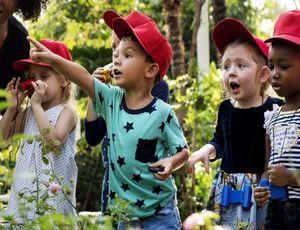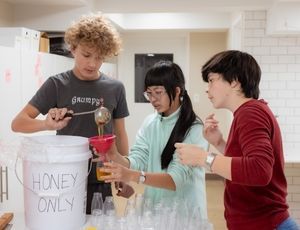Handwriting in the Montessori Classroom
In preparing the young child for what she called his “explosion into writing”, Montessori demonstrates her keen ability to analyze a skill in all its parts. Her genius in preparing the child for written expression lies in providing for the child exercises both in control of the hand and in analysis of the sounds of his/her spoken language. These carefully thought out exercises were planned to develop in advance the skills that would need to come together at a moment of intellectual insight : when the child is ready to express his thoughts in writing!
Montessori identified 4-4.5 years as the age at which the child is most ready to make the connection between the sounds of his spoken language and the written symbols for those sounds. (Montessori, 100). She developed the Sandpaper Letters for the child’s first pairing of the sounds and letters of the alphabet. The child repeats the sounds of these individual textured letters and traces them with his fingers, using the same sequence of motions he will later use to write the letters on paper. Upon mastery of the Sandpaper Letters, the child is introduced to the Movable Alphabet and uses his hands to arrange the letters to construct his repertoire of spoken words, spelling by the sounds, not the names of the letters. Ongoing lessons with the Movable Alphabet develop spelling skills, as the child builds increasingly complex words without ever picking up a pencil.
Montessori was careful to distinguish between the intellectual process of word building and the physical act of writing with pencil and paper. In the proper grip of the writing instrument and the movements necessary to form the letters of the alphabet, the hand needs its own preparation. Careful handling of the sensorial materials, practice with the Metal Insets and Sandpaper Letters, and daily work with the practical life activities refine the fine motor skills, develop the pincer grip, and prepare the child for the physical act of writing which is to come.
The act of communicating our thoughts on paper is a complex activity which involves physical coordination of movement, muscular memory, a specific grip on the writing instrument, memory of a set of symbols that represent specific sounds, not to mention left-to-right and up and down sequence, spacing between words, and placement on lined paper. As old habits can be very difficult to change, it is important that when children show an interest in writing and coloring, we help them to form good habits. Here are some suggestions of how you can foster writing habits that will serve your child well:
- When your child shows an interest in writing, provide short pieces of chalk and a chalkboard; for coloring, provide short pieces of crayons. Shorter pencils, chalk and crayons help to encourage the desired pincer (tripod) grip for writing.
- Teach your child lowercase letters. By far, the letters we write most are lowercase letters; capital letters are generally easily added later.
- If you wish to work with your child on handwriting, ask his/her teacher to send home a copy of the guide used at school to practice handwriting. This will provide consistency in practicing between school and home.
- When practicing handwriting, group letters for practice by similarities, e.g., letters with circles, letters with humps, letters with slanted lines, etc.
- When children are making their first attempts at writing letters with pencil, begin with unlined paper. When they feel secure in the correct pencil grip and formation of the letters, introduce lined paper. Check with your child’s teacher to source, if possible, the same paper used in the classroom.
- Try providing triangular pencils (Ticonderoga – My First Tri-Write) to encourage your child’s tripod grasp.
- Encourage, but follow your child’s lead to determine how long he/she is able to practice handwriting at a sitting. This varies, especially with younger children who may want to practice just a line or two at a time.
To learn more about the importance of handwriting and tips to encourage handwriting success, please visit:
References:
Montessori, Maria. The Formation of Man. Thiruvanmiyur, Madras: Kalakshetra Publications, 1985.






